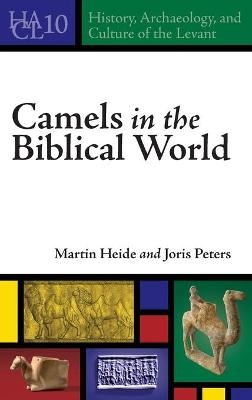
Camels in the Biblical World
Eisenbrauns (Verlag)
978-1-64602-136-9 (ISBN)
- Lieferbar (Termin unbekannt)
- Versandkostenfrei innerhalb Deutschlands
- Auch auf Rechnung
- Verfügbarkeit in der Filiale vor Ort prüfen
- Artikel merken
Camels are first mentioned in the Bible as the movable property of Abraham. During the early monarchy, they feature prominently as long-distance mounts for the Queen of Sheba, and almost a millennium later, the Gospels tell us about the impossibility of a camel passing through a needle’s eye. Given the limited extrabiblical evidence for camels before circa 1000 BCE, a thorough investigation of the spatio-temporal history of the camel in the ancient Near and Middle East is necessary to understand their early appearance in the Hebrew Bible.
Camels in the Biblical World is a two-part study that charts the cultural trajectories of two domestic species—the two-humped or Bactrian camel (Camelus bactrianus) and the one-humped or Arabian camel (Camelus dromedarius)—from the fourth through first millennium BCE and up to the first century CE. Drawing on archaeological camel remains, iconography, inscriptions, and other text sources, the first part reappraises the published data on the species’ domestication and early exploitation in their respective regions of origin. The second part takes a critical look at the various references to camels in the Hebrew Bible and the Gospels, providing a detailed philological analysis of each text and referring to archaeological data and zoological observations whenever appropriate.
A state-of-the-art evaluation of the cultural history of the camel and its role in the biblical world, this volume brings the humanities into dialogue with the natural sciences. The novel insights here serve scholars in disciplines as diverse as biblical studies, (zoo)archaeology, history, and philology.
Martin Heide is Associate Professor of Semitic Languages at the Center for Near and Middle Eastern Studies, Philipps-Universität Marburg. Joris Peters is Professor and Chair of Palaeoanatomy, Domestication Research and the History of Veterinary Medicine at the Ludwig-Maximilians-Universität München and Director of the Bavarian State Collection of Anthropology and Palaeoanatomy in Munich.
List of Illustrations
Foreword
List of Abbreviations
Chapter 1. Introduction
Chapter 2. Old World Camelids
2.1. Taxonomy, Evolutionary Adaptations, and Human Exploitation
2.1.1. Taxonomy
2.1.2. Evolutionary Adaptations
2.1.3. Human Exploitation
2.2. Ancestry and Early Domestication History
2.2.1. Ancestry
2.2.2. Early Domestication History
2.3. A Most Useful Hybrid
2.4. Ancient Camel Nomenclature
Chapter 3. Zooarchaeological, Iconographic, and Textural Evidence for the Presence of Camels in the Biblical World and Adjacent Regions
3.1. Camels in Central Asia and Iran
3.1.1. Camel Remains
3.1.2. Camel Iconography
3.1.3. Camels in Inscriptions from Iran
3.2. Camels in Mesopotamia and the Northern Levant
3.2.1. Camel Remains
3.2.2. Camels on Seals and Reliefs
3.2.3. Camel Figurines
3.2.4. The Cuneiform Record
3.2.5. Domestication Scenarios for the “Donkey of the Sealand”
3.3. Camels in Arabia
3.3.1. The Osteological Record
3.3.2. The Dromedary Saddle and Its Supposed Evolution
3.3.3. Dromedary Figurines
3.3.4. Camels in North Arabian Inscriptions and in Classical Arabic
3.3.5. Camels in South Arabian Inscriptions
3.3.6. Camels in Arabian Rock Art
3.3.7. Hybrids and Bactrian Camels in Arabia
3.4. Camels in Egypt
3.4.1. Camel Remains
3.4.2. Camel Figurines and Artistic Camel Representations
3.4.3. Camels in Ancient Egyptian Inscriptions and Literature
3.4.4. Camel Depictions in Rock Art in the Sinai Peninsula and in Egypt
3.5. Camels in the Southern Levant
3.5.1. Camel Remains
3.5.2. Camel Figurines and Camel Depictions
3.5.3. Camels from Israel and Judah in Inscriptions
Chapter 4. Camels in the Patriarchal Narratives and Israel’s Early History
4.1. The Text of the Hebrew Bible
4.1.1. Camels in the Biblical Manuscripts from Qumran
4.2. Camels in the Genesis Narratives
4.2.1. Abram and Sarai’s Sojourn in Egypt (Gen 12:10-13:1)
4.2.2. Abram’s Camels on Their Journey to Aram-Naharaim
4.2.3. Jacob’s Camels on His Return from Aram-Naharaim to Canaan
4.2.4. The Camels of the Ishmaelites and the Donkeys of the Patriarchs
4.2.5. Concluding Remarks
4.3. Camels and the Exodus
4.4. Camels in the Dietary Laws of the Pentateuch
4.5. Camels in the Book of Judges
4.6. Camels in the Books of Samuel
Chapter 5. Camels in the United and Divided Kingdoms
5.1. The Queen of Sheba and Her Caravan
5.1.1. Historical Considerations
5.2. The Forty Camel Loads from Syria
5.3. Incidents Involving Camels from the Books of Chronicles
5.3.1. The Camels of the Hagrites
5.3.2. Camels as Transport Animals in the Wake of the United Monarchy
5.3.3. Camels in the Royal Administration of King David
5.3.4. The Camels of “Zerah the Cushite”
Chapter 6. Camels in the Prophets and Other Writings
6.1. Camels in Isaiah’s Prophecies
6.1.1. The Advancing Enemy of Babylon
6.1.2. The Oracle Against Egypt
6.1.3. “Dust Clouds of Camels” in Israel’s Glorious Empire
6.1.4. Chariots, Dancing Camels, or Joyous People?
6.2. Camels in Jeremiah’s Prophecies
6.2.1. The Unreliable She-Camel and the Hot Jenny
6.2.2. The Oracle Against Qedar
6.3. Camels in the Book of Ezekiel
6.4. Camels in the book of Zechariah
6.5. Camels in the Book of Job
6.6. Camels on Their Return from Exile
Chapter 7. Camels in the Gospels
7.1. John the Baptist’s Ascetic Lifestyle
7.2. The Camel and the Needle’s Eye
Chapter 8. Domestic Camels in the Biblical World: Summary and Conclusions
Chapter 9. Epilogue
Bibliography
Index of Ancient Sources
Index of Animals
Index of Proper Names
Index of Terms
| Erscheinungsdatum | 28.07.2021 |
|---|---|
| Reihe/Serie | History, Archaeology, and Culture of the Levant |
| Zusatzinfo | 65 Halftones, black and white |
| Sprache | englisch |
| Maße | 152 x 229 mm |
| Gewicht | 726 g |
| Themenwelt | Geschichte ► Allgemeine Geschichte ► Vor- und Frühgeschichte |
| ISBN-10 | 1-64602-136-3 / 1646021363 |
| ISBN-13 | 978-1-64602-136-9 / 9781646021369 |
| Zustand | Neuware |
| Haben Sie eine Frage zum Produkt? |
aus dem Bereich


